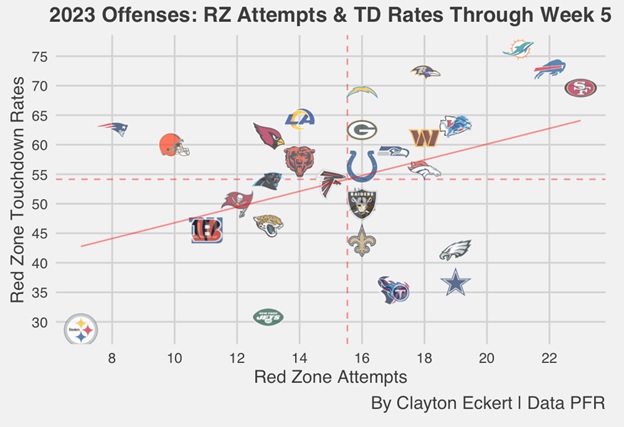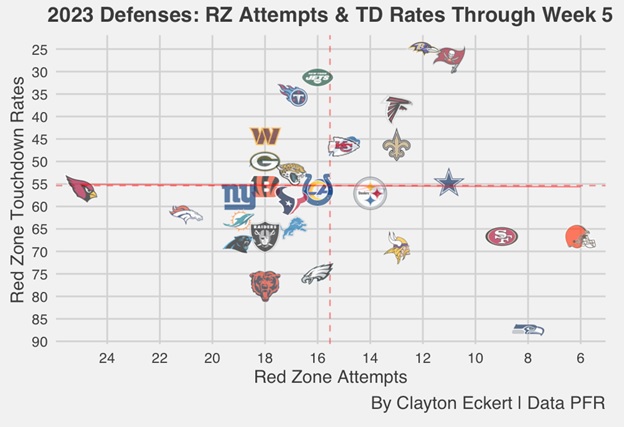Today I wanted to look at how NFL teams have fared in the red zone (at or inside the opponents 20-yard line), obviously a key component to the scoreboard. Here are NFL offenses attempts (drives) and touchdown rates:
Right away we see Pittsburgh in a lonely spot on the bottom left of the visual. The Steelers offense has only seven red zone drives, which is last in the league. Not only has the quantity been an issue, their 28.6 red zone touchdown rate is also dead last in the NFL, with no other team below 30-percent.
Just two touchdowns, both passes to TE Pat Freiermuth, one an out route that QB Kenny Pickett zipped in from three yards out, and the other a play-action boot left, hitting Muth on the corner route for the 13-yard score. Hopefully more of this is in store as Freiermuth returns from the hamstring injury that kept him out last week.
Diving deeper for more context, Pittsburgh has 20 plays in the red zone through five weeks, 15 passes and 5 runs. Considering the situation, this is when a “bully ball” team would be expected to lean on the run more. Discouragingly not the case for Pittsburgh, and a big change I’m hoping for following the bye.
Let’s look at success rates (40-percent on first down, 50-percent on second down, or six yards gained, and late downs resulting in a first down or touchdown). Of the five runs, two were successful (40-percent), both from RB Najee Harris. He had one other failed attempt, and both of RB Jaylen Warren’s runs failed, each going for a loss of two. Not only is Pittsburgh without a red zone rushing touchdown, they don’t have one at all, which is historically bad for the black-and-gold.
Four of the 15 passes went for successful plays, a painful 26.7-percent. Interestingly, both red zone passing touchdowns came on first down. The other two successes were to RB Anthony McFarland in his lone game, way back in week one. Nine red zone passes were incompletions, for a low 40-percent red zone completion rate. These issues have varied: route timing, accuracy, and decision making to name a few.
Yes, Pittsburgh has encouragingly enjoyed three explosive passing touchdowns, but have no successful passes in the red zone to WR’s, which hurts to write. The red zone numbers are painful to hear and must improve moving forward, getting there more often, and capitalizing when they do. Knock on wood the bye week will provide the time to adjust and make much needed improvements.
While I was at it, I wanted to see how defenses have fared as well:
The Steelers defense lands above the NFL mean with 14 red zone drives defensed (T-10th), respectable for being on the field the second most total plays in the league. When teams get in the red area, Pittsburgh has allowed a 57.1 red zone touchdown percentage (T-18th) which is slightly below the NFL mean.
That equates to eight touchdowns allowed, six passes and two runs. Of the six passes, 49ers WR Brandon Aiyuk had two amidst his big game in week one (both allowed by Steelers CB Patrick Peterson), along with Cleveland RB Jerome Ford (CB Chandon Sullivan), Raiders WR Davante Adams (CB Levi Wallace/Peterson), and two in week four against the Texans: WR Nico Collins (Wallace) and a HB pass from Devin Singletary to TE Dalton Schultz (Peterson).
The two rushing touchdowns allowed came in week two (Browns RB Pierre Strong Jr.) from a yard out, and a 14-yard yarder from Ravens RB Justice Hill last week. The latter was an all-situations issue of poor run lanes/angles in 2023, LB Cole Holcomb and CB Desmond King on this particular play. With this in mind, it is encouraging to see only two red zone touchdowns, and three total on the season (knocks on wood).
The Steelers have defended 43 plays in the red zone, 27 passes and 16 runs. In total, they have kept the opposition from successful plays 25 times, for a 58.1 success rate (larger rates are best). 21 of those have impressively gone for no gain or a loss of yards (48.8-percent). Pittsburgh’s defense was successful at stopping eight runs (50-percent success rate), but an important nugget is seven of those were on first down.
In the pass game, they’ve stopped 17 red zone passing plays (63-percent) including three sacks: from DL Larry Ogunjobi, edge rushers Markus Golden, and T.J. Watt, with the latter including a forced fumble. The other highlight came last week on an interception from rookie CB Joey Porter Jr., the only such play in the red zone this season.
I also looked into two-point conversion numbers, where the offense is 0/2, and the defense has allowed 3/3, not good Bob. Factoring that into touchdowns on both sides of the ball, Pittsburgh has a red zone touchdown/two-point conversion differential of -9, ouch.
So, it’s been very feast or famine for Pittsburgh’s defense, creating negative plays or allowing touchdowns and not much in between. Hopefully they find more consistency as the teams driving force of success (or lack thereof). The Steelers offense has a way to go in many areas of course, but being dead last as a red zone offense emphasizes another glaring issue, and how lucky the team is to be 3-2 on top of the AFC North.
Thanks for reading and let me know your thoughts in the comments.










